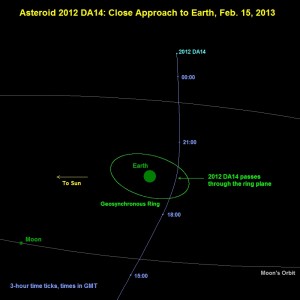
Drawing of the path of near-Earth asteroid 2012ge DA14 when it passes close to Earth on Feb. 15, 2013. (NASA)
Earth is about to have a close encounter with an asteroid, the nearest an object of its size has ever come to our planet.
The fly-by is expected to occur at around 1924 UTC on Feb. 15, according to scientists at NASA’s Jet Propulsion Laboratory.
The US space agency says there’s no chance the asteroid will collide with Earth.
“This is a record-setting close approach,” says Don Yeomans of NASA’s Near Earth Object Program at JPL. “Since regular sky surveys began in the 1990s, we’ve never seen an object this big get so close to Earth.”
Scientists expect the asteroid to pass us at a distance of about 27,700 km from the surface of the Earth. That’s close enough for it to pass inside the ring of a number of geosynchronous weather and communications satellites currently orbiting the Earth at about 36,000 km from Earth’s surface above the equator.
However, the asteroid should fly well above most of the satellites and spacecraft circling the planet, including the International Space Station (ISS).
To get an idea of just how close the 2012 DA14 asteroid will get to us, consider that it will come nearer to us than the moon, about 1/13th of the distance to the Moon, which is 384,400 km from Earth.
It’s expected to whiz by our planet quite fast, at a speed of about 7.8 kilometers per second in a south-to-north direction. This will be the closest an asteroid has come to Earth in at least 30 years and will give researchers a unique opportunity to study it.
The 2012 DA14 is quite small, weighing about 130,000 metric tons and measuring about 45 meters across, less than the width of a soccer field. Astronomers believe it is made of stone, rather than metal or ice.
The asteroid was discovered by astronomers at the OAM Observatory in La Sagra, Spain less than a year ago, on Feb. 23, 2012, which is why “2012” is part of its name.
NASA video feature of asteroid fly-by
A few other asteroids have flown even closer to Earth, but they were much smaller than the one expected to zoom by this month. Scientists say objects of this size fly this close to the Earth about once every 40 years; an actual collision with Earth happens about every 1,200 years.
The 2012 DA14 asteroid is so tiny, it’s expected to look like a small point of light, even to those using the biggest optical telescopes. Difficult to see with the naked eye, it will be easily visible with a good set of binoculars or a small telescope.
Astronomers say the best place to see the asteroid will be in Indonesia, but people in Eastern Europe, Asia and Australia should also be able to get a glimpse.
The public can watch the event through live feeds from telescopes in La Sagra and Tenerife, Spain.
NASA astronomers at the Goldstone Deep Space Communications Complex (GDSCC) in California’s Mojave Desert will use radar imaging to determine the orbit of the asteroid, allowing them to better predict future encounters. The imaging data will also be used to create a 3D map showing the asteroid from all sides and should reveal more about the asteroid’s physical characteristics, such as its size and spin.





















WhY would happen if unexpectently something came in like armeggedon and knocked it off its course?